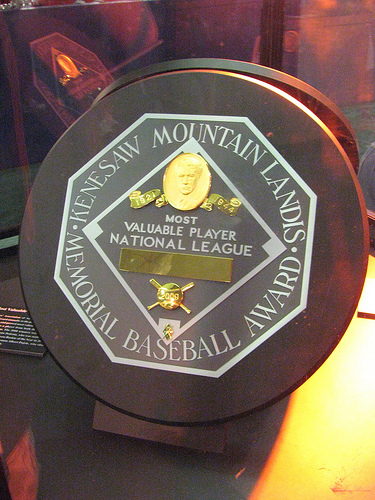The 2011 Phillies dominated major league baseball with the
best record thanks to their starting pitching.
When Ruben Amaro Jr. pieced together a rotation of aces, the likes of
which we last saw in Atlanta during the 1990’s, he envisioned the starting
rotation to be the Phillies key to success.
His vision has come to fruition.
No pundit would argue that the Phillies could have sustained the best
record in Major League Baseball without the likes of Roy Halladay, Cliff Lee,
Cole Hamels, Roy Oswalt, and even Vance Worley.
This
article will focus on Roy Halladay’s contribution to the team. This year marks Halladay’s second season in a
Phillies uniform. Since he stepped on
the mound in Philadelphia, Halladay has proven his worth by dominating
hitters. His resume in Philadelphia
includes a perfect game, a playoff no-hitter, and the 2010 National League Cy
Young award. This prosperity derives
from pitching fundamentals, work ethic, and tenacity. As Cole Hamels put it,
“There's a reason he’s done so well in his
career, and it comes from his incredible work ethic and his desire to win.”[1]
It did,
however, take time for Roy Halladay to develop his signature style. 1999 and 2000 proved to be difficult seasons
for Halladay. In his first chance to
pitch in the big leagues, he experienced control issues. In 1999 Halladay compiled 79 walks in 149.1
innings pitched. In 2000 he resolved
some of his control issues, but he became too hittable, giving up 107 hits in
67.2 innings pitched. After being shut
down by the Blue Jays, Halladay resolved to rework his mechanics. Instead of throwing from directly over the
top, an angle from which the most velocity can be generated, Halladay began to
throw from a sixty-degree angle. This
“three quarters” angle of pitching allowed Halladay to deceive hitters by
deviating from the norm. Throwing from
this angle lowered his speed but consequently allowed him to add more sink,
cut, and tailing action to his fastball.
These variations in the 2-seam fastball became Halladay’s staple,
leading to great success.
Halladay
saw immediate results. Only once since
2000 had he acheived an earned run average above 3.92. Along with lower earned run averages,
Halladay saw his strikeout totals rise and walk totals reach all-time
lows. Despite accumulating over two
hundred strikeouts many times in his career, Halladay’s pitching style plays to
contact. Cutters, sinkers, and tailing
fastballs generally do not generate strikeouts, but groundballs. Hitters can more easily time a 91 mph cutter
than a 96 mph four-seam fastball, but due to the cutter’s additional movement,
Halladay jams the hitter or forces the hitter to hit the top of the ball
causing more groundballs. Between 2004
and 2011 Halladay’s groundball to flyball ratio has been as high as 1.60. Due to his fantastic control and his ability
to throw both his changeup and curveball for strikes, as well as use them as
“put away” pitches, Halladay has dominated hitters. His flexibility is best encapsulated by
Halladay’s former teammate Benji Molina.
“Roy is like a machine. He’s the type of
pitcher that doesn’t care what happens around him. He still is going to get the
batters out any way he can. That’s what makes him a lot better than most.”[2]
In addition
to his refined mechanics, three quarters throwing style, and excellent use of
his variety of pitches, Halladay embodies the quintessential hard-worker. Halladay diligently works on his routine
between starts, utilizing a lifting program, stretching, and cardiovascular
workouts to ready himself for his next turn on the hill. According to Phillies manager Charlie Manuel,
"He
[Roy] comes in here and he's always doing something…He never sits still. He
talks to you very short and then says he has to go running or whatever. He
definitely has a routine and a program and he's going to stay on that. Nothing
is going to get in his way. That's a commitment every day and that's
good."[3]
The third
key to Halladay’s success stems from his mentality and approach to
pitching. Halladay displays persistence
and determination in all games he pitches.
This mentality makes him a Cy Young candidate every year, and the
ability to potentially pitch a complete game every time. Halladay’s durability eases the strain on the
bullpen and solidifies his supremacy at the top of the Phillies rotation. Ten of his 19 wins in 2011 came following
a Phillies loss. Fans count on “Doc”
Halladay, as he is colloquially known, to ameliorate the pain of a loss by
following it up with a victory.
Recently,
however, Halladay has revealed a chink in his armor, surrendering more runs in
the first inning, 14, than in any other inning.
Batters hit .274 in the first inning against Halladay in comparison to
the .239 they hit against him overall.
During the first inning Halladay has a 3.66 ERA and has given up 34
hits. Although these are average numbers
for most pitchers, they show vulnerability rarely portrayed by Doc Halladay.
Despite
this minor flaw, Halladay has been the consummate leader of the Phillies
staff. His delivery is fluid and
compact, with perfect balance midway through his motion, a long stride towards
the plate, and a simple follow through.
Such elegance and pursuit of perfection are the foundation of Halladay’s
dominance and durability.



